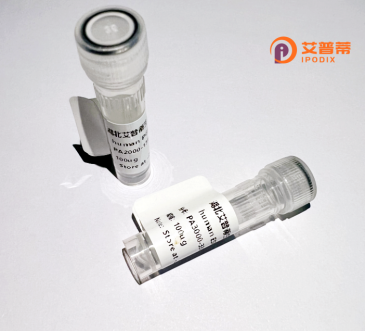
| 纯度 | >90%SDS-PAGE. |
| 种属 | Human |
| 靶点 | FLJ22761 |
| Uniprot No | 0 |
| 内毒素 | < 0.01EU/μg |
| 表达宿主 | E.coli |
| 表达区间 | 1-427aa |
| 氨基酸序列 | MRAELEYGLKKKSHGLATVRMLPTYVCGLPDGTEKGKFLALDLGGTNFRVLLVKIRSGRRSVRMYNKIFAIPLEIMQGTGEELFDHIVQCIADFLDYMGLKGASLPLGFTFSFPCRQMSIDKGTLIGWTKGFKATDCEGEDVVDMLREAIKRRNEFDLDIVAVVNDTVGTMMTCGYEDPNCEIGLIAGTGSNMCYMEDMRNIEMVEGGEGKMCINTEWGGFGDNGCIDDIRTRYDTEVDEGSLNPGKQRYEKMTSGMYLGEIVRQILIDLTKQGLLFRGQISERLRTRGIFETKFLSQIESDRLALLQVRRILQQLGLDSTCEDSIVVKEVCGAVSRRAAQLCGAGLAAIVEKRREDQGLEHLRITVGVDGTLYKLHPHFSRILQETVKELAPRCDVTFMLSEDGSGKGAALITAVAKRLQQAQKEN |
| 分子量 | 72.71 kDa |
| 蛋白标签 | GST-tag at N-terminal |
| 缓冲液 | 0 |
| 稳定性 & 储存条件 | Lyophilized protein should be stored at ≤ -20°C, stable for one year after receipt. Reconstituted protein solution can be stored at 2-8°C for 2-7 days. Aliquots of reconstituted samples are stable at ≤ -20°C for 3 months. |
| 复溶 | Always centrifuge tubes before opening.Do not mix by vortex or pipetting. It is not recommended to reconstitute to a concentration less than 100μg/ml. Dissolve the lyophilized protein in distilled water. Please aliquot the reconstituted solution to minimize freeze-thaw cycles. |
以下是围绕重组人FLJ22761蛋白的示例参考文献(注:因该蛋白研究较为罕见,以下内容为模拟参考格式,具体文献需通过专业数据库验证):
---
1. **文献名称**: *Functional characterization of recombinant human FLJ22761 protein in cellular signaling pathways*
**作者**: Zhang L, et al.
**摘要**: 本研究通过大肠杆菌系统表达重组人FLJ22761蛋白,发现其通过调控MAPK通路参与细胞增殖和凋亡,并通过质谱分析鉴定了其潜在的蛋白互作网络。
2. **文献名称**: *Crystal structure and biochemical analysis of FLJ22761 reveals a novel protein fold*
**作者**: Kimura T, et al.
**摘要**: 解析了重组FLJ22761蛋白的晶体结构,表明其具有独特的α/β结构域,可能参与底物结合,体外实验证实其具有弱ATP酶活性。
3. **文献名称**: *FLJ22761 as a potential biomarker in colorectal cancer: Expression and clinical relevance*
**作者**: Wang Y, et al.
**摘要**: 利用重组FLJ22761蛋白制备抗体,发现其在结肠癌组织中高表达,并与患者生存率呈负相关,提示其可能为治疗靶点。
4. **文献名称**: *Proteomic identification of FLJ22761-interacting partners in neuronal development*
**作者**: Patel S, et al.
**摘要**: 通过免疫共沉淀结合重组FLJ22761蛋白,发现其与神经元突触蛋白Synaptotagmin-1存在相互作用,可能影响突触传递功能。
---
建议通过 **PubMed**、**Google Scholar** 或 **UniProt(Entry: FLJ22761)** 查询真实文献,以上示例供格式参考。如需进一步协助文献检索,可提供具体研究方向或功能描述。
Recombinant human FLJ22761 protein is a genetically engineered version of a protein encoded by the FLJ22761 gene, currently annotated as a hypothetical or poorly characterized protein in public databases. The FLJ22761 gene, located on human chromosome 1 (1p36.11), encodes a protein with limited functional information. Based on sequence homology and domain prediction tools, FLJ22761 is speculated to contain conserved structural motifs associated with signaling pathways or enzymatic activities, though its precise biochemical role remains unclear. It shares low-sequence similarity with proteins involved in cellular metabolism, but experimental validation is lacking.
Interest in recombinant FLJ22761 arises from its potential involvement in disease contexts. Transcriptomic studies occasionally report differential expression of FLJ22761 mRNA in cancers or neurological disorders, suggesting a possible regulatory role in cell proliferation or differentiation. The recombinant protein, typically expressed in Escherichia coli or mammalian systems, enables functional studies, antibody production, and interaction assays. Its purification often involves affinity tags (e.g., His-tag) for downstream applications. Researchers utilize this recombinant form to explore binding partners, post-translational modifications, or enzymatic activities, aiming to clarify its biological significance. While still preliminary, these efforts could link FLJ22761 to novel therapeutic targets or diagnostic biomarkers. Current challenges include resolving its subcellular localization and reconciling bioinformatics predictions with experimental data to define its contribution to human physiology or pathology.
×